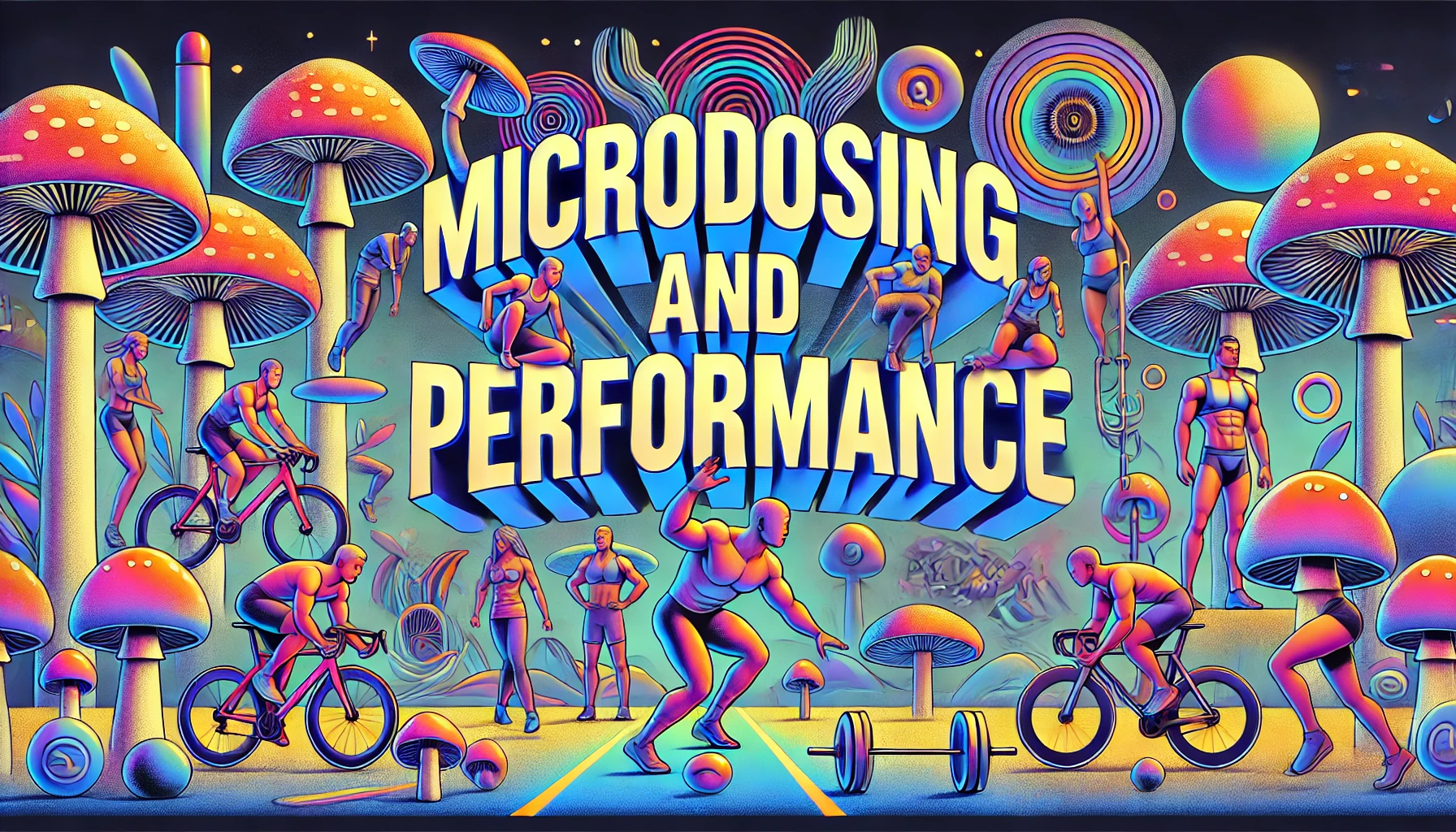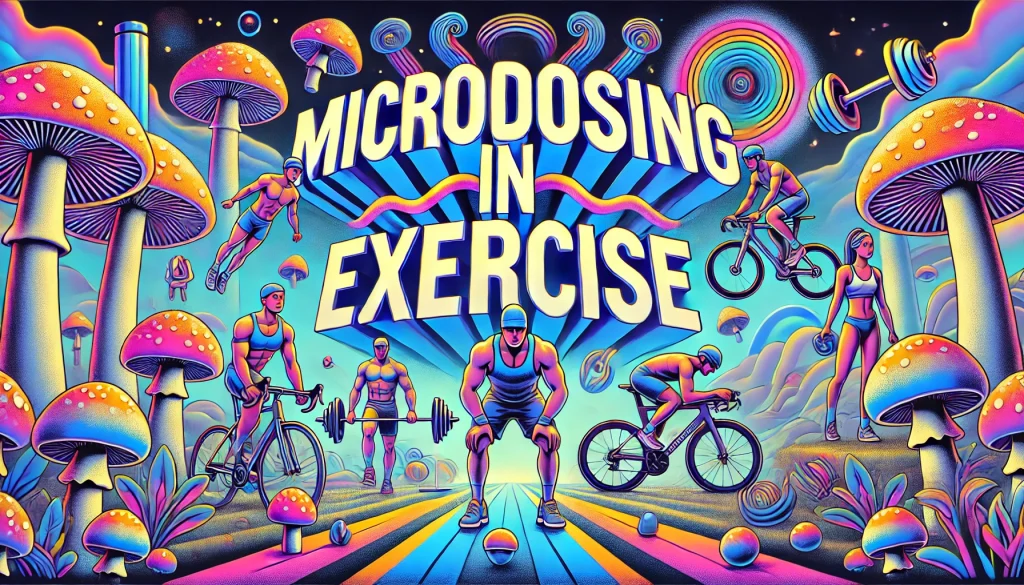

Microdosing and Exercise: How Psilocybin Can Boost Your Workout Performance
Imagine shaving minutes off your personal best or discovering a newfound mind-body connection during your workouts. Sounds too good to be true, right? Well, hold onto your gym shorts, because there’s a buzzing trend in the fitness world that’s got everyone from weekend warriors to pro athletes talking: microdosing psilocybin for exercise enhancement.
Magic mushrooms? For working out? Are you nuts? Hear me out, because this isn’t about getting high while you’re trying to lift weights – it’s about managing the therapeutic side of this natural supplement..
Microdosing refers to taking tiny, sub-perceptual doses of psychedelics, and it’s been gaining traction in Silicon Valley for years as a way to boost productivity and creativity. But now, it’s making its way into locker rooms and gyms, with some fitness enthusiasts swearing by its ability to enhance physical performance.
Here’s a few benefits that are being discussed in 2024:
- Enhanced Focus and Mind-Muscle Connection
- Increased Endurance and Pain Tolerance
- Improved Recovery and Reduced Inflammation
- Heightened Sensory Awareness
- Breaking Through Plateaus
We’re about to take a deep look into the world of microdosing and exercise. We’ll explore the potential benefits, the risks (because let’s face it, nothing’s perfect), and what science has to say about this unconventional pairing. Whether you’re a curious newbie or a seasoned gym rat looking for that extra edge, buckle up – we’re in for one heck of a ride!
Understanding Microdosing and Psilocybin
Alright, let’s start with the basics. What the heck is microdosing, anyway? Well, it’s pretty much what it sounds like – taking really, really small doses of a substance. We’re talking about amounts so tiny that you don’t feel high or see pink elephants dancing around your treadmill.
In this case, we’re focusing on psilocybin, the active compound in magic mushrooms. Now, before you start having flashbacks to that one wild college party, remember: we’re dealing with doses that are about a tenth (or less) of what you’d take to trip.
Psilocybin is a naturally occurring psychedelic compound that’s been used for centuries in spiritual and medicinal practices. At higher doses, it can cause hallucinations, altered perceptions, and intense emotional experiences. But at microdoses? The effects are much more subtle.
Here’s where it gets interesting for us fitness freaks. Some people report that microdosing psilocybin can enhance focus, boost mood, increase creativity, and even improve physical performance. It’s like having a really good day, where everything just clicks – but potentially more consistent.
Now, I’ve got to be clear here: microdosing is worlds apart from recreational use. We’re not talking about gobbling down shrooms before hitting the gym. That would be like chugging a bottle of tequila before a marathon – a terrible, potentially dangerous idea.
The goal with microdosing is to find that sweet spot where you’re getting potential benefits without any psychedelic effects. It’s a delicate balance, and it’s definitely not for everyone. But for those who’ve found their groove with it, the results can be pretty impressive.
The Science Behind Microdosing for Physical Performance
First things first: psilocybin works by binding to serotonin receptors in the brain, particularly the 5-HT2A receptor. This interaction can lead to increased neural plasticity, potentially allowing for new connections and thought patterns. In the context of exercise, this could translate to improved mind-muscle connection and better movement patterns.
A study published in the Journal of Psychopharmacology found that psilocybin can increase blood flow to the brain. More blood flow means more oxygen, and more oxygen could potentially lead to better cognitive function during exercise. It’s like giving your brain a little extra fuel for those tough workouts.
Another fascinating aspect is psilocybin’s potential impact on inflammation. A 2021 study in the National Library of Medicine suggests that psilocybin might have anti-inflammatory properties. Given that inflammation is a key factor in exercise recovery, this could be huge for athletes looking to bounce back faster from intense training sessions.
Keep in mind, most of the studies on psilocybin and physical performance are still in their infancy. We’re talking about a field that’s as fresh as that new gym equipment smell. But the early results? They’re showing a lot of promise.
Another study on microdosing psychedelics (not just psilocybin) found that participants reported improved mood, cognition, and creativity. While this wasn’t specifically focused on exercise, it’s not hard to see how these benefits could translate to better workouts.
Here’s my take: the science is promising, but it’s still early days. We need more research, particularly studies that focus specifically on microdosing psilocybin for athletic performance.


Reported Benefits of Microdosing for Exercise
Time to look into the benefits that have fitness enthusiasts talking about microdosing.
- Enhanced Focus and Mind-Muscle Connection: This is a big one. Many users report an almost zen-like state during workouts, where they feel hyper-connected to their bodies. It’s like being “in the zone,” but cranked up to eleven. I remember the first time I experienced a real mind-muscle connection during a bicep curl – it was like I could feel every fiber contracting. Microdosing enthusiasts claim this sensation becomes more accessible and consistent.
- Increased Endurance and Pain Tolerance: Here’s where things get really interesting. Some athletes report being able to push through their usual limits, claiming that discomfort feels more manageable. It’s not that the pain disappears, but rather that it becomes easier to observe it without being overwhelmed by it. As someone who’s hit the wall during many a long run, the idea of pushing past those barriers is pretty appealing.
- Improved Recovery and Reduced Inflammation: Remember that anti-inflammatory potential we talked about earlier? Well, some users swear by microdosing for faster recovery times. They report less soreness and stiffness after tough workouts. Now, as someone who’s tried every recovery trick in the book (ice baths, anyone?), this benefit, if proven, could be a game-changer.
- Heightened Sensory Awareness: This one’s fascinating. Users often describe feeling more in tune with their environment during exercise. Colors might seem more vivid, sounds clearer. For activities like trail running or rock climbing, this enhanced awareness could potentially improve performance and safety.
- Breaking Through Plateaus: We’ve all been there – stuck at the same weight, unable to shave those last few seconds off our time. Some microdosers report that the practice helps them break through these stubborn plateaus, possibly due to the combination of improved focus, endurance, and mind-body connection.
Now, I’ve got to emphasize again – these benefits are largely based on personal reports. The placebo effect is real, and it’s possible that some of these improvements come from the expectation of enhanced performance rather than the microdose itself. But here’s the thing: in the world of sports and fitness, the mental game is huge. If microdosing helps some athletes get into a more positive, focused headspace for their workouts, that alone could lead to improved performance.
What Are The Risks of Microdosing Mushrooms?
As exciting as the potential benefits of microdosing for exercise might sound, we’ve got to address the elephant in the room – the risks and legal considerations.
First up, let’s tackle the big one: legality. In most parts of the world, psilocybin is still classified as an illegal substance. This means that using it, even in microdoses, could land you in hot water legally. It’s crucial to be aware of the laws in your area.
Now, onto the potential side effects. While microdosing is designed to be sub-perceptual, some people might still experience:
- Mild anxiety or restlessness
- Changes in perception (which could be dangerous during certain exercises)
- Digestive discomfort
- Sleep disturbances
Another critical point: dosage and timing. Getting the dose right is crucial. Too much, and you could find yourself in an altered state mid-workout – not exactly ideal when you’re trying to bench press or navigate a busy gym. It’s a delicate balance that requires careful experimentation and, ideally, guidance from a knowledgeable professional.
For competitive athletes, there’s another major consideration: drug testing. Many sports organizations consider psilocybin a banned substance. Even tiny amounts could show up on a drug test, potentially derailing your athletic career. It’s not worth the risk if you’re competing at a level where you might be tested.
Let’s not forget about interactions with other substances. Psilocybin can interact with various medications and supplements. If you’re on any kind of prescription meds, especially antidepressants, it’s crucial to consult with a healthcare provider before even considering microdosing.
Lastly, there’s the psychological aspect. While many report positive mood effects from microdosing, it’s not suitable for everyone. Those with a history of mental health issues, particularly psychosis or severe anxiety, should steer clear.


How to Incorporate Microdosing into Your Fitness Routine
First things first:
Finding the right dosage. This is crucial and highly individual. A typical microdose of psilocybin is about 1/10th to 1/20th of a regular dose. For dried mushrooms, this could be as little as 0.1 to 0.3 grams. Remember that potency can vary wildly depending on the strain and growing conditions. Starting with the absolute minimum and gradually adjusting is key.
Finding the right type of magic mushrooms. All strains are going to affect you differently, so understanding how each strain affects your body is critical to positive results.
Timing is another critical factor. Many users report best results when microdosing on an empty stomach, about an hour before their workout. But again, this can vary. Some prefer to microdose on rest days to focus on recovery. It’s all about finding what works for you through careful experimentation.
Types of Exercises Microdosing Might Positively Benefit
Endurance Activities
- Why: Potential for increased focus and pain tolerance, which could be beneficial for long-duration activities.
Yoga and Mind-Body Exercises
- Why: Reported increase in body awareness and mindfulness, potentially enhancing the mind-body connection.
High-Intensity Interval Training (HIIT)
- Why: Possible improvements in mental resilience and recovery between intense bursts of activity.
Strength Training
- Why: Enhanced mind-muscle connection and potential for improved form and technique.
Endurance activities like long-distance running or cycling are often cited as being particularly enhanced. The potential for increased focus and pain tolerance could be beneficial here. Yoga and other mind-body exercises are also popular choices, given the reported increase in body awareness. High-intensity interval training might benefit from improved mental resilience, while strength training could see gains from an enhanced mind-muscle connection.
A study published in the Journal of Psychopharmacology explored the effects of microdosing on cognitive function and mood. The research, conducted over several weeks, found potential improvements in various cognitive domains, including focus and creativity, which could have implications for exercise performance.
But here’s a crucial point: start with familiar exercises in a safe environment. The last thing you want is to be trying a new, complex movement or using heavy weights while you’re still figuring out how microdosing affects your day. Tracking your results and experiences is absolutely essential. Keep a detailed journal of your doses, timing, workouts, and how you feel both during and after. Look for patterns and be honest with yourself about both positive and negative effects. This data is invaluable for optimizing your approach – and for knowing when to stop if you’re not seeing benefits or experiencing adverse effects.
Lastly, consider your social support system. Having a trusted friend or training partner who knows about your microdosing can be a safety net. They can provide objective feedback on any changes in your behavior or performance and help out if you experience any unexpected effects.
Remember, the goal here isn’t to radically alter your consciousness during workouts. If you’re feeling high, you’ve taken too much. The effects should be subtle – a slight boost in mood, focus, or endurance, not a psychedelic experience.
And please, for the love of all things iron, don’t combine microdosing with other performance-enhancing substances or pre-workout supplements. That’s a recipe for disaster.
In the end, incorporating microdosing into your fitness routine should be a thoughtful, measured process. It’s not for everyone, and that’s okay. Listen to your body, stay safe, and never prioritize performance over your health and well-being.
Tommy Lee
Table of Contents
Canada’s Mushroom Dispensary
Calgary
We deliver magic mushrooms same day in Calgary. Enjoy quick delivery within 60 minutes anywhere within city limits between 10am and 9pm daily.
Canada
Canada's magic mushroom delivery service. We bring shrooms to your place in 1 - 4 days depending where you are in Canada. Shrooms near me? We have you covered.
Be first on the list to get notified about our sales, new genetics and drops before they sell out!

